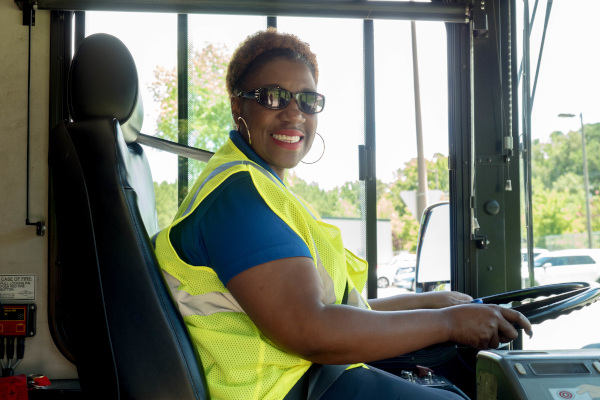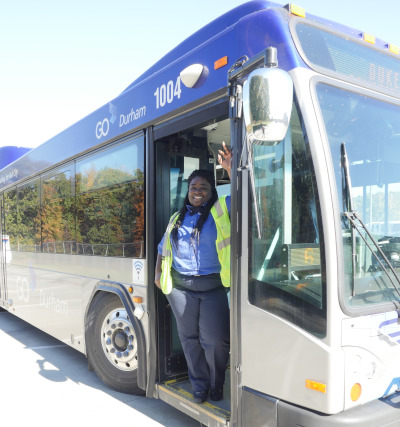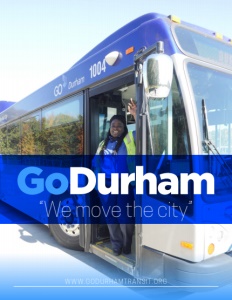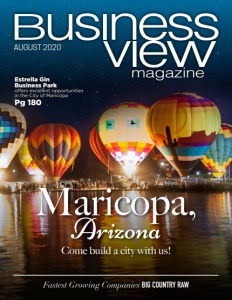GoDurham
“We move the city”
Business View Magazine interviews Doug Middleton, General Manager of GoDurham, for our focus on American Public Transit and Transportation Infrastructure.
As communities everywhere learn to navigate a “new normal,” public transit will play an ever-increasing role as both essential service and a trusted means to move about. In the City of Durham, North Carolina, GoDurham is that vital people-mover. The City of Durham entered into the transit business in 1991, when it assumed responsibility over the transit system previously operated by Duke Power Company. At that time, the Durham Area Transit Authority (DATA) fixed route service was provided through a transit management contract with a third party management company. In October 2010, the City of Durham entered into an agreement with Triangle Transit to oversee the management of Durham’s fixed route and demand-response services. Then in March 2015, as part of a regional re-branding effort, DATA became GoDurham and Triangle Transit became GoTriangle.
GoDurham’s mission is to set the standard of excellence in the Triangle region for passenger transportation services by providing safe, reliable, convenient, and accessible transportation for the city’s citizens and visitors. That commitment, accomplished by exceeding customer expectations and treating each other with respect and dignity, has made GoDurham a trusted, essential connection for the entire Durham community.
Recently, Business View Magazine spoke with Doug Middleton, General Manager of GoDurham, for his insights into the current operations, how they’re adapting to challenges faced during the COVID-19 pandemic, and what’s on tap for the future of this progressive and very busy public transit system. The following is an edited transcript of that conversation.

BVM: Can you give us an overview of GoDurham from an operations perspective?
Middleton: “GoDurham has been in existence for about 30 years, and I’ve been here for the past three. It is a sub-corporation of the city, legally known as Durham City Transit Company (DCTC), operating under the brand ‘GoDurham’ and owned by First Transit. We are a very well-run organization, which I credit to our dedicated employees. We do a good job here; it’s a very powerful transit system for the community.
“We run 12 base routes, with variations on those that bring the number up to 20, overall, and we employ a team of about 200 employees, total. In transit terms, that’s small- to mid-sized. Our biggest employee classifications are Bus Operators and Maintenance employees, which constitutes mechanics, service attendants, facility attendants and management. Everyone in Operations and Maintenance, except management, are union employees. We are budgeted for 126 Bus Operator positions and maintain 90 to 95 percent staffing, fluctuating between 112 and 120 operators. Our total bus count stands at 58, right now, and we have a pull requirement of 45 buses. The maximum number of buses that we pull out during the peak hours is 45, which is also the number of buses we keep in service throughout the day. By the way, that’s unusual for a transit system. Typically there is a peak pullout during morning and afternoon rush periods and in between those busy periods buses come out of service because less buses are needed on the road during off peak hours to provide service to fewer customers. But we keep our buses out for 15 to 16 hours a day without a break because the demand for service is there.”
BVM: How often do you update your bus fleet?
Middleton: “Our oldest buses, which we’re trying to retire as quickly as possible, are vintage 2003. Our newest models are 2019 and in between those model years are – 2007s, 2009s, 2012s, 2017s, and 2018s. The federal government provides funds to help procure rolling stock, infrastructure, and other capital expenses. Under their plan, they recommend replacing buses every 12 years or 500,000 miles. Obviously, we go beyond that with our 2003s and 2007s, but we would prefer to adopt the recommended replacement schedule as it becomes expensive to run older buses at some point and reliability starts suffering .
 “The exciting thing is that we’re taking delivery of two electric buses at the end of 2020 to replace some of our oldest 2003 buses. E-buses represent the newest technology and will allow us to operate more efficient and move towards a more sustainable fleet. Adopting full electric technology is something most transit systems are leaning towards doing these days. Design-wise, the e-buses will maintain a similar look and functionality to what we have now, and are coming from Gillig – a well-rooted and experienced transit manufacturer. When they decided to do electric, they came out with a really great product and they’re rapidly gaining momentum among transit systems. Through our evaluation, the Gillig electric buses stood out among the other competitors and we’re excited to bring them into our fleet.
“The exciting thing is that we’re taking delivery of two electric buses at the end of 2020 to replace some of our oldest 2003 buses. E-buses represent the newest technology and will allow us to operate more efficient and move towards a more sustainable fleet. Adopting full electric technology is something most transit systems are leaning towards doing these days. Design-wise, the e-buses will maintain a similar look and functionality to what we have now, and are coming from Gillig – a well-rooted and experienced transit manufacturer. When they decided to do electric, they came out with a really great product and they’re rapidly gaining momentum among transit systems. Through our evaluation, the Gillig electric buses stood out among the other competitors and we’re excited to bring them into our fleet.
“GoDurham has also been a bit of a test bed for Continental Tire. We’ve worked with them in developing technologies around tire monitoring for their business and, of course, we benefit from that as well. They’ve been a great partner for us because tires are obviously important, and expensive, as they wear out fast on heavy equipment. Another important partnership is Clarke Power Services. They do a great deal of parts repairs and work on our battery hybrid buses, which comprise a large portion of our fleet. They are integral to our success.”
BVM: What special services do you offer riders?
Middleton: “All buses on our fixed transit system are configured to support seniors and disabled customers. They have wheelchair lifts and ramps for any of our customers who have difficulty traversing steps. Our buses also “kneel”, they actually drop down using our hydraulic system that brings them closer to the ground or the curb – that reduces the distance a person has to step up or down. Our ‘sister ship,’ GoDurham Access, has a dedicated fleet and routes specifically for individuals who qualify to ride those systems based on their disabilities. The Access models are highly-equipped for people who can’t navigate the fixed route system at all or have a very difficult time doing so.
“And GoDurham has new payment technology coming soon. We have contracted with Delerrok, an electronic fare collection system provider, to integrate mobile ticketing and we’re gearing up to do a soft launch in October. Instead of paying cash, or buying a physical day pass, customers will be able to load those fare media onto their smart phone or device through an app, and use it on our buses via a reader that scans their phone and deducts the fare accordingly. Within that technology, there is the ability to fare cap and that will probably be launched with the mobile ticketing, as well.”
BVM: How is GoDurham adapting during the coronavirus pandemic?
Middleton: “Speaking to the business challenges presented by COVID-19, the big impact is the reduction in ridership. Here’s the kicker – for 30 years in the industry, I’ve been espousing the benefits and advantages of using public transit and I’ve been out in the front lines promoting our industry for many years; talking to city councils and business districts and promoting service. And now I’m doing the opposite. Telling people to stay off the system and only take it for essential rides. That was painful for me and probably the biggest challenge. However, as a transit system, GoDurham has fared better than most. Many systems have lost 70 to 90 percent of their ridership, we’re probably at 50 to 60 percent of normal, as of the time of this interview, which is pretty darned good comparatively. Public transit is a tremendous essential service, especially in Durham, where a lot of people rely on the bus system. The things we had to do to protect our employees and our riders is really extreme but critical. And we have now resumed full service.”
BVM: What are the goals for the next five years?
Middleton: “Most transit systems have a five or 10 and 20 year strategic plan. We’re a little different, in that the city establishes the plans for us – they create plans and work with us through our partnership with GoTriangle. That being said, I have my own goals and desires for where I think public transit should start thinking strategically and devoting resources. And there are a lot of defining paradigms that are going to occur over the next few years. It’s hard to say with much confidence where we’ll be in the future, because we (as an industry, not just an agency) have to figure out right now what happens post-pandemic. Are we going to be able to restore our full ridership or are we going to have to change our service delivery model to improve efficiency and safety first to attract riders back? All transit systems are grappling with how to restore that service, otherwise, fixed route transit becomes an untenable model because it’s just too expensive to operate. For example, I could only put about four to six people on my bus, if I wanted to legitimately social distance on a 40-foot bus that could carry standing loads of up to 70 or 80 people, pre-pandemic service.
“So, our model may change dramatically, and that probably means a lot more support from third-party transportation providers, such as Uber and Lyft, that can help us modify and augment the way we deliver our service. We’re already doing some of that now – it started pre-pandemic when we were thinking strategies. With a pilot program we call East Durham Connect, we partner with Lyft to provide a an on demand circulator for customers who need to get from their residence onto a main bus line. I envision a lot more of that in the future; much more on-demand travel, less highly structured, more flexible options for people to move around. Fixed-route, mass transit has to figure out how to be more fluid and adaptable. Technology is going to help us move a long way in that regard, going forward, because right now there’s a big question mark.
“You won’t find another transit system that has the productivity we have. I often refer to our organization as one that fights up in weight. Because we are 58 buses, running 216,000 service hours, but our stats on paper make us appear like a much larger transit service. We do half a million rides per month – six million rides per year – a lot of systems two and three times our size don’t have that kind of ridership. Pre-pandemic, we averaged as high as 34 passengers per hour. Those are pretty staggering numbers. What I’m saying is that GoDurham is a huge mobility life line and economic generator. We’re incredibly important and critical to this community. We really move the city residents and visitors and we take a lot of pride in that.”
AT A GLANCE
GoDurham
What: Fixed route public transit system
Where: Durham, North Carolina
Website: www.godurhamtransit.org
PREFERRED VENDORS
Clarke Power Services – www.clarkepowerservices.com
For more than 55 years, Clarke Power Services has focused every day on delivering one goal: provide outstanding value to our customers. With Clarke, you’re working with the industry leader in providing individual and comprehensive repairs for all makes and models of trucks. Authorized dealers for Detroit Diesel, Allison Transmissions, MTU, Perkins and Mercedes-Benz. Clarke offers 22 full-service shops and 150-plus mobile trucks across 9 states. Clarke keeps commercial vehicle assets operational and equipment life cycle on track.




